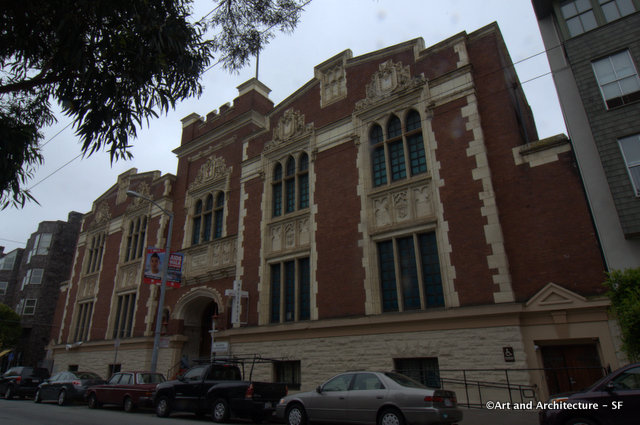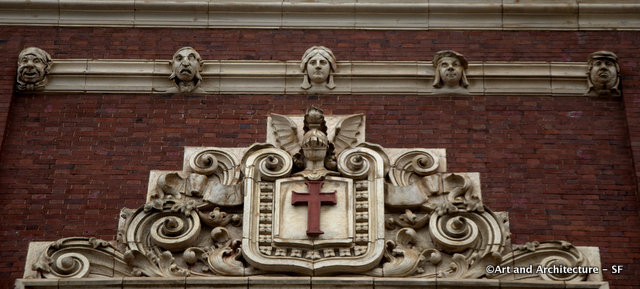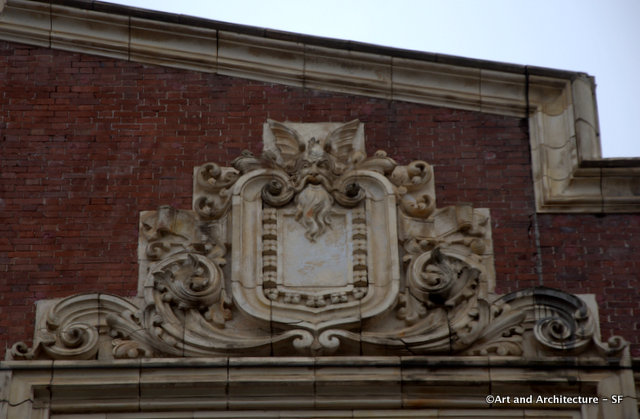2135 Sutter Street
Western Addition
This steel reinforced building with brick exterior walls trimmed in lots of terra cotta was designed by Matthew O’Brien and Carl Werner in the architectural style known as the Jacobean Phase of Medieval Revival. It was built in 1905 and 1906-1907.
The building has been home to two institutions, the Knights Templar and the Baptist Church. The building was originally built for the Golden Gate Commandery #16 of the Knights Templar, a masonic order at the turn of the century. In the 1950’s there was a decline of masonic and other fraternal groups in the city, possibly as a result of a movement towards the suburbs, and the Knights Templar moved to a smaller building.
The building was then bought by the Macedonia Missionary Baptist church in1950.
Martin Luther King Jr. preached at the Church in the late fifties and early sixties, making the church the center of much of the activities that took place regarding the civil rights movement.
O’Brien & Werner had their offices at 1683 Ellis Street in San Francisco. Between the two of them they designed and built several San Francisco movie palaces like the Orpheum, the Tivoli Opera House (later the Columbia), the Hippodrome, Golden Gate Theater, The Princess Theater, and the Valencia Theater. They designed the Golden Eagle Hotel and three buildings in the Alamo Square Historic District.
Carl Werner was born in 1875 in Philadelphia and was at one time the unofficial architect for the city of Alameda. Werner was a mason and it is possibly one reason that Werner and O’Brien received the commission.
Look at the wonderful terra cotta faces that grace the building. The sculptural elements are drawn from both the Knights Templar imagery and Gothic architecture.
This building was deemed San Francisco Landmark #202 in 1993
The Knights Templar is an international philanthropic chivalric order affiliated with Freemasonry. Unlike the initial degrees conferred in a Masonic Lodge, which only require a belief in a Supreme Being regardless of religious affiliation, the Knights Templar is one of several additional Masonic Orders in which membership is open only to Freemasons who profess a belief in the Christian religion. The full title of this Order is The United Religious, Military and Masonic Orders of the Temple and of St John of Jerusalem, Palestine, Rhodes and Malta. The word “United” in this title indicates that more than one historical tradition and more than one actual Order are jointly controlled within this system. The individual Orders ‘united’ within this system are principally the Knights of the Temple (Knights Templar), the Knights of Malta, the Knights of St Paul, and only within the York Rite, the Knights of the Red Cross. The Order derives its name from the historical Knights Templar, but does not claim any direct lineal descent from the original Templar order.
The historical Knights Templar trace their origin back to shortly after the First Crusade. Around 1119, a French nobleman from the Champagne region, Hugues de Payens, collected eight of his knight relatives including Godfrey de Saint-Omer, and began the Order, their stated mission to protect pilgrims on their journey to visit the Holy Places. They approached King Baldwin II of Jerusalem, who allowed them to set up headquarters on the Temple Mount. The Dome of the Rock, at the centre of the Mount, was understood to occupy the site of the Jewish Temple. Known to Christians throughout the Muslim occupation of Jerusalem as the Holy of Holies, the Dome of the Rock became a Christian church, the Templum Domini, the Temple of the Lord. But the Templars were lodged in the Aqsa Mosque, which was assumed to stand on the site of Solomon’s Temple. Because the Aqsa mosque was known as the Templum Solomonis, it was not long before the knights had encompassed the association in their name. They became known as the Pauperes commilitones Christi Templique Solomonici – the Poor Fellow-Soldiers of Christ and of the Temple of Solomon, which was shortened to “Knights Templars”.



The details are beautiful!
A magnificent building with some gorgeous details.
Bullshit story, but nice building